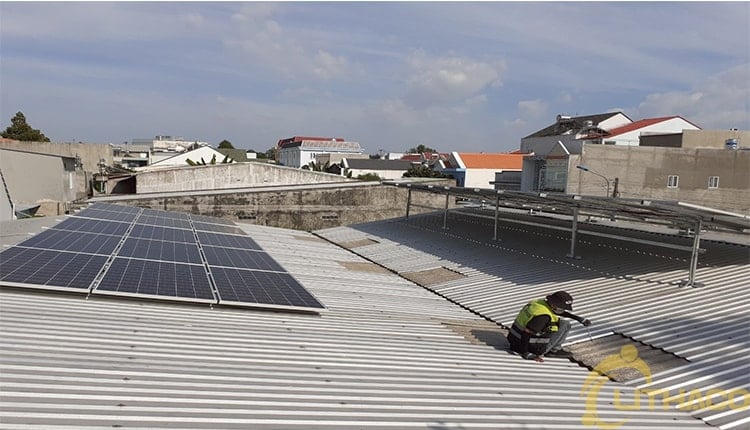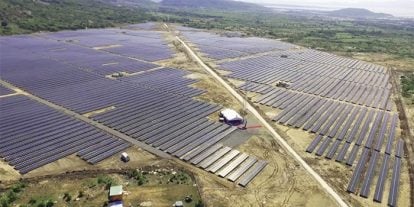Từ chỗ chú trọng phát triển điện hạt nhân, điện khí và nhiệt điện than, sau thảm họa sóng thần và sự cố Nhà máy Điện hạt nhân Fukushima năm 2011, Chính phủ Nhật Bản đã chuyển hướng sang phát triển năng lượng tái tạo.

Trước sự cố Fukushima, Nhật Bản chưa chú trọng phát triển năng lượng tái tạo. Tỉ lệ của năng lượng tái tạo (bao gồm cả thủy điện) chỉ tăng từ 3,5% vào năm 1990 lên 4,6% vào năm 2002. Đến năm 1999, Nhật Bản mới sử dụng năng lượng mặt trời để phát điện với công suất 209 MW. Giai đoạn này, Nhật Bản chú trọng phát triển điện hạt nhân, điện khí thiên nhiên và nhiệt điện than, giảm sử dụng dầu do giá dầu đắt đỏ.
Tuy nhiên, sau sự cố Fukushima, Nhật Bản buộc phải thay đổi chiến lược phát triển điện hạt nhân, chuyển sang sử dụng năng lượng tái tạo. Để thu hút nguồn vốn đầu tư vào lĩnh vực này, đặc biệt là năng lượng mặt trời (NLMT), Chính phủ Nhật Bản cam kết giá mua điện ổn định trong 10 năm với giá 44 Yên/kWh (tương đương 44 cent/kWh), mức giá cao nhất thế giới tại thời điểm đó. Kết quả, công suất lắp đặt của NLMT tăng mạnh, từ 5.000 MW năm 2011 lên 25.000 MW năm 2014. Trong đó, hệ thống NLMT trên mái nhà phát triển rất nhanh (chiếm 82,7% tổng công suất điện mặt trời), còn các các dự án NLMT thương mại chỉ chiếm 17,3%.
Trong khi các dự án điện mặt trời thương mại gặp một số khó khăn đặc thù, chính sách về phát triển năng lượng tái tạo đã thật sự kích thích các nhà đầu tư bỏ vốn vào hệ thống NLMT trên mái nhà. Hệ thống này khắc phục được những hạn chế của các dự án NLMT lớn như: giảm tiền thuê đất, không cần thiết phải kí hợp đồng tiêu thụ điện với các công ty điện lực địa phương…

Việc đẩy mạnh phát triển các hệ thống điện mặt trời lắp mái đã tạo điều kiện cung cấp điện cho từng hộ tiêu thụ. Mô hình này cũng từng bước làm thay đổi căn bản cấu trúc của lưới điện phân phối ở Nhật Bản theo hướng đảm bảo kết nối nguồn năng lượng nhỏ lẻ, mỗi hộ gia đình vừa là đơn vị tiêu thụ, vừa là đơn vị phát điện.
Còn với các dự án NLMT công suất lớn, mặc dù được kì vọng rất nhiều, nhưng lại không mấy thành công, do sự thay đổi chính sách của Chính phủ trong việc hỗ trợ các nguồn năng lượng tái tạo; do khó khăn trong bồi thường giải phóng mặt bằng và chuyển đổi đất nông nghiệp thành đất công nghiệp. Ngoài ra, các dự án năng lượng mặt trời công suất lớn cũng khó ký hợp đồng cung cấp điện với 4 công ty điện lực của Nhật Bản, do nguồn năng lượng này có tính bất ổn cao, khi hòa vào lưới điện sẽ làm giảm tính ổn định của hệ thống.
Mục tiêu của Nhật Bản là đến năm 2030 NLMT sẽ chiếm 12% tổng công suất nguồn điện.
Phải chăng người Nhật mua ‘hớ’? Câu trả lời là không phải như vậy, người Nhật hiểu rằng thay vì bỏ hàng chục tỷ USD để xây lại Fukushima mới họ dùng một phần số tiền để khuyến khích người dân.
Việt Nam cũng đang đối diện với nguy cơ thiếu điện, nhưng thay vì làm giống nước Nhật, dường như chúng ta đang làm ngược lại.
Place emphasis on the development of nuclear power, thermal power and coal gas, after the tsunami and the nuclear power plant Fukushima in 2011, the Government of Japan has shifted to renewable energy development.

Prior to the incident in Fukushima, Japan did not focus on developing renewable energy. The share of renewable energy (including hydroelectricity) only increased from 3.5% in 1990 to 4.6% in 2002. Until 1999, Japan only used solar energy to generate electricity. capacity of 209 MW. During this period, Japan focused on developing nuclear power, natural gas energy and coal thermal power, reducing oil use due to expensive oil prices.
However, after the Fukushima incident, Japan was forced to change its nuclear power development strategy to switch to renewable energy. To attract capital to invest in this field, especially solar energy, the Japanese Government committed to a stable electricity purchase price for 10 years at 44 Yen / kWh (equivalent to 44 cents / kWh), the The highest price in the world at that time. As a result, the installed capacity of solar energy increased sharply, from 5,000 MW in 2011 to 25,000 MW in 2014. In particular, rooftop solar power system developed very fast (accounting for 82.7% of total solar power capacity. heaven), while commercial solar energy projects only account for 17.3%.
While commercial solar power projects face some particular difficulties, the policy on renewable energy development has really stimulated investors to invest capital in rooftop solar power systems. This system overcomes the limitations of large solar projects such as reducing land rent, no need to sign power consumption contracts with local power companies …

The development of roof-mounted solar power systems has facilitated the supply of electricity to each consumer household. This model also gradually changes the structure of the distribution grid in Japan in the direction of ensuring the connection of small power sources, each household is both a consumer and a generating unit
As for large capacity solar power projects, although expected a lot, it was not very successful, due to the Government’s policy change in supporting renewable energy sources; due to difficulties in site clearance compensation and conversion of agricultural land into industrial land. In addition, it is difficult for large-capacity solar projects to sign power supply contracts with four Japanese power companies, because this source of energy is highly unstable, when being connected to the grid, it will reduce System stability: The goal of Japan is that by 2030 solar power will account for 12% of the total power capacity.
Affordable Japanese buy ‘wrong’? The answer is not so, the Japanese understand that instead of spending tens of billions of dollars to rebuild Fukushima they use part of the money to encourage people. Vietnam is also facing the risk of electricity shortage, but instead of being like Japan, it seems we are doing the opposite.










